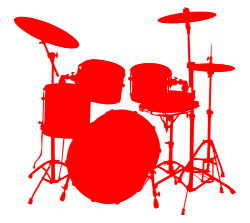Today I’m going to teach you how to practice Stick Control by George Lawrence Stone. You can follow along in the book if you have a copy, but if not you’ll still learn a lot about stick control techniques by studying this lesson.
1. The first thing you need to be able to do to practice stick control effectively is to be able to bounce the stick off the head like a ball. Getting started you want to Use a very loose grip. I teach my students to make the a okay sign using the thumb and index finger only. Just slip the stick in the hole you’ve made with your finger and thumb. Each stick is different but you want to find the place the stick balances so that you can easily bounce it of the head or practice pad. It’s definitely easier to learn this on a tight head or practice pad. So if you need to, tighten up your head.
2. After you’ve learned the basic technique of bouncing the stick off the head you can start practicing the book. Start with exercise one which is on page 5 of the book. The sticking is just RLRL. Let the stick rebound about 6”to 9”. These are called half strokes. Take care that you’re not pulling the stick back up to the top position. It should bounce off the head like a ball. Again in the beginning just use a very loose grip. Don’t hold onto the stick at all with your thumb and index finger in the beginning. Start slow. Play each exercise like this 4x. Then move on to the next. You can practice pages 5-7 this way. You don’t have to play all those pages either. You can just practice the first 8 exercises and it will accomplish the same thing for this particular exercise.
3. When you start to feel like you have good control of the half strokes and can bounce the stick easily and consistently, increase the size of the stroke all the way up perpendicular to the head. These are called full strokes. Throw the stick and make it bounce all the way back up. Again The most common mistake I see beginners make is lifting the stick back to the top. In order to develop speed you need the stick to do a lot of the work for you. So throw it hard and make it bounce all the way back up on its own. Again this is done in the beginning with a very relaxed grip, and you use mostly your wrists to make the stroke.
Practice half strokes and full strokes using pages 5-7 15 minutes a day for a week or two. Practice slow, with a metronome, approximately 8th note = 60-80 bpm. This is not a speed exercise. It’s more of a coordinated strength exercise.
4. After you have good control over half and full strokes and bouncing the stick using a very loose grip you should start working on more control, more precision with the sticks. Practice pages 5-7 again using softer strokes, about 3”-5” inches off the head. These are called taps. Keep your hands totally relaxed, but wrap your fingers and thumb around the stick. Play each exercise 4-20x without stopping. Practice with a metronome and gradually build up your speed. Don’t play any faster than you can play relaxed.
At slower speeds the strokes you’re playing are basically single strokes, and you’ll use mostly wrists. As you start speeding the exercises up, you’ll be playing double strokes for some of the exercises.
You’ll use more fingers at faster tempos. By the way I have a very effective and somewhat unusual exercise for developing your finger technique further on this page.
Continue practicing half and full strokes 5-10 minutes daily along with the taps. Be patient and persistent. In the beginning try to practice stick control 20 minutes a day and you will see fast results.
This is the first video in a series on stick control. I will be doing more soon.
I also have a very extensive and detailed stick control course I’ve created as well that you should check out. It’s called Killer Stick Control In 30 Minutes A Day.
